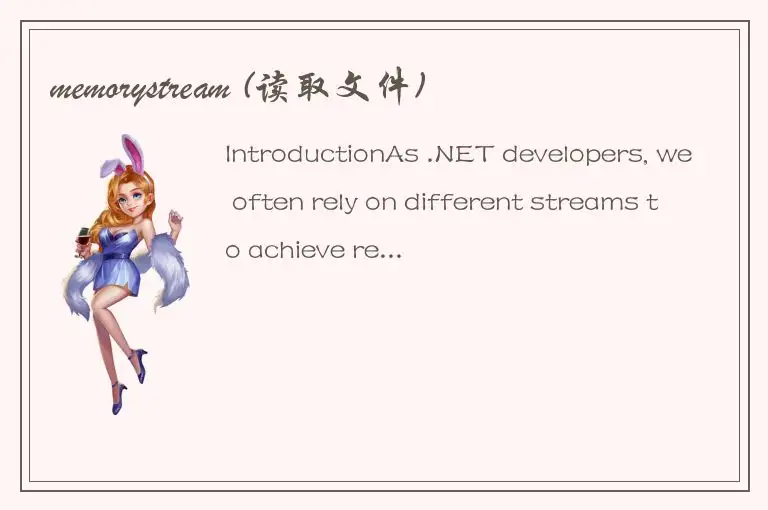Introduction

As .NET developers, we often rely on different streams to achieve reading and writing operations across file systems or other data sources. One of the most versatile of these streams is the MemoryStream class, which we'll explore throughout this article.
The MemoryStream class is a C# class that allows developers to work with a stream of data stored entirely in memory instead of a file. The MemoryStream class acts like the FileStream class, but instead of reading and writing data from a file, it works with the data stored in memory.
In this article, we will dive into the MemoryStream class and explore its use cases and versatility. We'll cover how to create a MemoryStream object, how to write data to it, and how to read data from it, as well as some best practices to consider when working with it in your .NET applications.
Creating a MemoryStream Object
We can create a new instance of the MemoryStream class in various ways, but the following two are the most common ones:
1. Using the empty constructor:
```csharp
var memoryStream = new MemoryStream();
```
2. Using an array of bytes:
```csharp
var buffer = new byte[1024];
var memoryStream = new MemoryStream(buffer);
```
In the second example, we can create a MemoryStream object preloaded with data by passing a byte array to its constructor. The MemoryStream object would then have the capacity equal to the length of the byte array passed.
Writing Data to MemoryStream
Once we have created a MemoryStream object, we can write data to it in several ways. We can use the Write method, which writes a specified number of bytes directly to the underlying buffer of the MemoryStream object. Here's an example:
```csharp
byte[] buffer = Encoding.ASCII.GetBytes("Hello World");
var memoryStream = new MemoryStream();
memoryStream.Write(buffer, 0, buffer.Length);
```
In this example, we are converting the "Hello World" string into a byte array using the Encoding.ASCII.GetBytes method. Next, we create a MemoryStream object and call its Write method, passing the byte array, the starting index, and the length of the buffer as parameters.
We can also use the BinaryWriter class to write data to a MemoryStream object. Here's an example:
```csharp
var memoryStream = new MemoryStream();
var binaryWriter = new BinaryWriter(memoryStream);
int value = 10;
binaryWriter.Write(value);
double dvalue = 20.55;
binaryWriter.Write(dvalue);
```
In this example, we are creating a new instance of MemoryStream and BinaryWriter classes. We then use the BinaryWriter.Write method to write integer and double values to the MemoryStream object.
Reading Data from MemoryStream
To read data from a MemoryStream object, we use the Read method of the MemoryStream class, which reads a specified number of bytes from the underlying buffer. Here's an example:
```csharp
byte[] buffer = Encoding.ASCII.GetBytes("Hello World");
var memoryStream = new MemoryStream();
memoryStream.Write(buffer, 0, buffer.Length);
memoryStream.Position = 0;
var readBuffer = new byte[memoryStream.Length];
memoryStream.Read(readBuffer, 0, (int)memoryStream.Length);
```
In this example, we are first writing a byte array containing the "Hello World" text to a MemoryStream object. Next, we set the Position property of the MemoryStream object to 0 to read from the beginning of the buffer.
Finally, we create another byte array of the same size as the MemoryStream object and use the Read method to read the data from the MemoryStream object into the readBuffer byte array.
We can also use the BinaryReader class to read data from a MemoryStream object. Here's an example:
```csharp
var memoryStream = new MemoryStream();
var binaryWriter = new BinaryWriter(memoryStream);
int value = 10;
binaryWriter.Write(value);
double dvalue = 20.55;
binaryWriter.Write(dvalue);
memoryStream.Position = 0;
var binaryReader = new BinaryReader(memoryStream);
int integerValue = binaryReader.ReadInt32();
double doubleValue = binaryReader.ReadDouble();
```
In this example, we're using the same MemoryStream object and BinaryWriter class as in the previous example to write data to it. We first reset the Position property of the MemoryStream object to 0.
Next, we instantiate the BinaryReader class and use its ReadInt32 and ReadDouble methods to read the integer and double values we wrote earlier.
Best Practices
Here are some best practices to keep in mind when working with MemoryStream objects:
1. Always call the Dispose method on MemoryStream objects when we are finished using them to free up memory.
2. When working with large amounts of data, consider using the FileStream class instead of MemoryStream to avoid out of memory exceptions.
3. Avoid using MemoryStream objects to store sensitive data like passwords or credit card numbers as the data is stored in memory, which can be accessed by unauthorized parties.
Conclusion
The MemoryStream class is an incredibly versatile and useful tool in the .NET developer's toolkit. It allows us to read from and write to a stream of data stored entirely in memory, and it's straightforward to use.
In this article, we covered how to create a MemoryStream object, how to write data to it, and how to read data from it. We also discussed some best practices to keep in mind when working with MemoryStream objects.
With the MemoryStream class, we can build more efficient and performance-oriented applications in .NET, and that's always a good thing!




 QQ客服专员
QQ客服专员 电话客服专员
电话客服专员